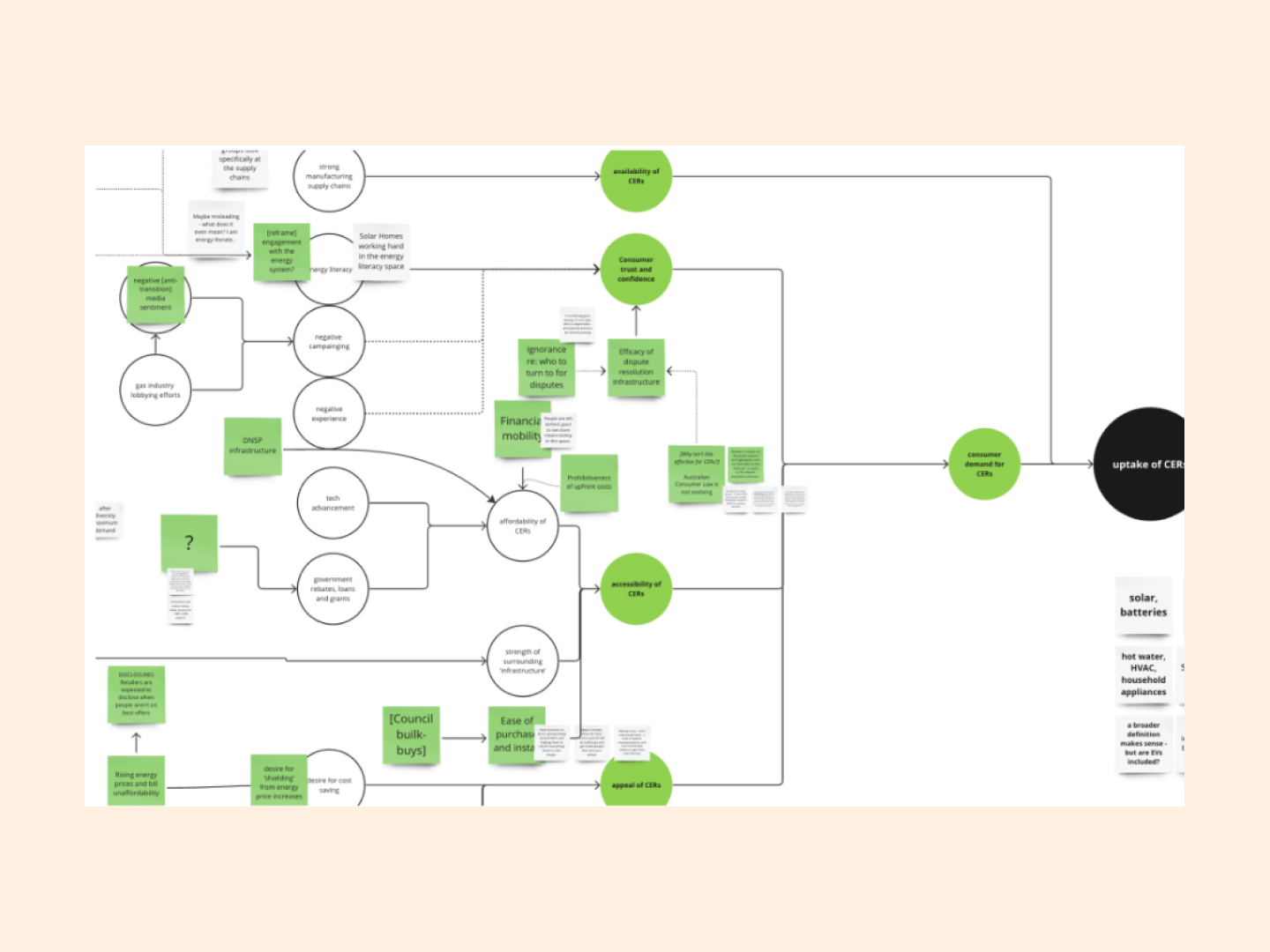State Electricity Commission
Mapping Victoria’s energy future through consumer participation
We worked with the State Electricity Commission (SEC) to understand and map the system surrounding consumer energy resources (CERs) and identify opportunities to better harness them.

Outcomes
- A comprehensive systems map: The detailed map captures the factors influencing CER uptake and the orchestration programmes that utilise them. It serves as both an analytical tool and a communication device, helping diverse stakeholders understand their role in the larger system.
- Strengthened stakeholder relationships: The engagement process itself created value for the SEC as a new and potentially disruptive organisation. By bringing stakeholders into the mapping process, we helped establish the SEC as a collaborative force for change rather than just another regulatory body.
- Strategic opportunities for intervention: The key stories and associated opportunities we identified now inform the SEC's strategic planning processes. These aren't just problems to solve but specific, actionable pathways toward their vision of democratised energy.
Services
- Systems mapping
- Strategic research
Sectors
The challenge: Democratising energy in a complex system
The State Electricity Commission—a newly reformed organisation transforming Victoria's energy sector—approached us with an ambitious vision: democratising energy choices whilst reducing bills for households across the state.
At the heart of this challenge are consumer energy resources (CERs)—those small-scale electricity assets connected to the grid that many of us have at home. Solar panels on rooftops, hot water heat pumps, electric vehicles, even pool pumps. These resources represent enormous potential for households to take control of their energy use, reduce costs through improved efficiency, and earn from feed-in tariffs.
But here's where it gets complex: whilst CER uptake benefits individual households, orchestrating these resources at scale could unlock system-wide benefits—financial, social, and environmental. Yet this proliferation also creates significant challenges for retailers, distributors, and regulators who must accommodate rapid change whilst maintaining the safety, reliability, and stability we all depend on.
The SEC recognised this as a critical opportunity to understand the system dynamics at play and identify interventions that could accelerate CER uptake whilst supporting the broader energy transition.
Our approach: Making sense of complexity through collaborative mapping
We began with the SEC's strategic framework, which proposed three scales at which consumer value could be created:
- The home: Individual household benefits
- The network: Local community and grid advantages
- The market: System-wide value creation
These hypotheses became our anchors – reference points that helped frame conversations and connect the multitude of stories we would hear about operational, market, and regulatory factors.
Gathering diverse perspectives
Understanding a system this complex required speaking with those who live and work within it daily. We engaged subject matter experts across the energy ecosystem:
- Consumer advocacy groups
- Local and state government representatives
- Manufacturing sector participants
- Energy distribution networks
- Energy retailers
- Regulatory bodies
Each conversation added layers to our understanding. We explored the dynamics that help or hinder consumers' ability to benefit from CER ownership. We investigated how orchestration programmes could support system flexibility and manage increased energy generation and exports.

We took simple systems maps into our stakeholder interviews, using their contributions to develop and validate new relationships as we spoke.
Iterative mapping process
Our systems mapping wasn't a desk exercise—it was a living document that evolved with each stakeholder engagement. We brought preliminary maps into interviews, using them as conversation starters and collaborative tools. Stakeholders could see their insights being incorporated in real-time, validating relationships and identifying gaps in our understanding.
This approach helped:
- Make abstract system dynamics tangible and discussable
- Stakeholders see how their piece connected to the whole
- Build buy-in for the final outputs through co-creation

Zooming out, a high-level map structure outlined how the systems map could explore our client's strategic hypotheses around value.
What we discovered: Key stories and intervention points
Through our research and mapping, patterns emerged. We identified crucial dynamics affecting CER uptake and orchestration—some acting as accelerators, others as barriers.
Extracting actionable insights
Rather than leaving the SEC with just a complex map, we highlighted specific 'key stories'—critical pathways through the system where targeted interventions could create significant change. Each story represented a leverage point where the SEC could potentially influence system behaviour.
These weren't just theoretical observations. We annotated each key story to demonstrate how the systems map could be used as a practical tool—unpacking specific dynamics to find tangible solutions for change.

Key stories were extracted and annotated to demonstrate how the systems map can be used to unpack specific dynamics and find tangible solutions for change.
Reflections: Systems thinking for energy transition
This project reinforced several crucial insights about working with complex systems:
Visualisation makes complexity manageable: The act of mapping helped stakeholders see connections they hadn't recognised before, even within their own domains.
Co-creation builds understanding and buy-in: By involving stakeholders in the mapping process rather than just interviewing them, we created shared ownership of the insights.
Multiple perspectives reveal the whole: No single stakeholder held the complete picture. The system only became clear through the synthesis of diverse viewpoints.
The energy transition isn't just about technology—it's about understanding and reshaping the complex systems that govern how energy is produced, distributed, and consumed. Through systematic mapping and stakeholder engagement, we helped the SEC identify where and how to intervene in this system to accelerate positive change.
